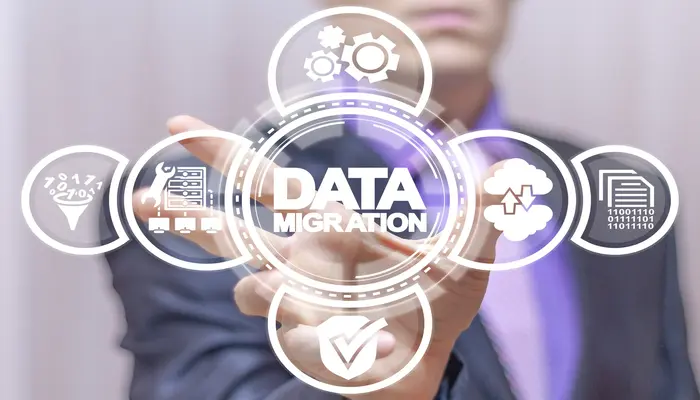15
+
YEARS OF
EXPERIENCE
1000
+
SUCCESSFUL
Projects
80
+
Satisfied
Clients

The backbone of modern UAE businesses is their information technology (IT) infrastructure. Whether you’re a small startup or a global corporation, your IT systems play a pivotal role in daily operations, customer service, and strategic decision-making. However, the IT landscape is ever-changing, and organizations must adapt to stay competitive and secure. This is where IT migrations come into play. IT migrations involve the transfer or transformation of various IT assets, services, and data from one state to another. They are the key drivers behind modernization and optimization efforts, ensuring that businesses can keep pace with technological advancements and evolving market demands.
In this comprehensive guide, we’ll explore the critical importance of IT migrations and delve into when and why they’re needed. From navigating the intricate process of mergers and acquisitions to the imperative need for legacy system upgrades, we’ll uncover the scenarios that trigger IT migrations. We’ll also address the growing trends, such as cloud adoption and data center relocations, that propel organizations toward migration projects. Finally, we’ll examine how compliance requirements often act as catalysts for change within the IT landscape.
However, it’s crucial to acknowledge that IT migrations come with their own set of challenges. The transition from old to new can be fraught with complications, from potential data loss to downtime disruptions. Throughout this guide, we’ll also shed light on the obstacles organizations may encounter on their migration journey, emphasizing the need for careful planning, execution, and mitigation strategies.
As we embark on this exploration of IT migrations, you’ll gain a deeper understanding of their significance in the modern business world and the pivotal role they play in shaping the future of organizations, ensuring their resilience, and enhancing their competitiveness.
There are several key aspects to consider when understanding data migration:
- Types of Data to Migrate: Data migrations can involve structured data (e.g., databases), unstructured data (e.g., documents), and semi-structured data (e.g., XML files). Each type presents unique challenges and considerations.
- Data Migration Strategies: Organizations must choose the most appropriate migration strategy, such as a one-time bulk migration, incremental migration, or real-time synchronization, based on their specific needs and constraints.
Data Migration Best Practices
Successful data migrations require careful planning and adherence to best practices. Failing to do so can result in data loss, corruption, or costly disruptions. Here are some key best practices to consider:
- Data Assessment and Inventory: Begin by conducting a comprehensive assessment of your data. Understand its volume, structure, and quality. Create an inventory of all data sources to be migrated.
- Data Cleaning and Deduplication: Before migration, cleanse and deduplicate data to eliminate inconsistencies and reduce the risk of transferring redundant or inaccurate information.
- Data Mapping and Transformation: Develop a clear mapping plan that defines how data in the source system corresponds to data in the target system. Ensure that data is transformed, if necessary, to fit the new schema or format.
- Data Validation and Testing: Rigorous testing is crucial. Verify that data is successfully migrated and that it retains its integrity. Conduct validation checks to ensure that data matches expectations.
Overcoming Data Migration Challenges
Despite meticulous planning, data migrations can encounter challenges along the way. Doing so requires forethought, immediate action, an attention to the protection of sensitive data, and an approach that minimises operational downtime as much as possible. Of course, prevention is always better than cure, so considering an outsourced IT company to help you avoid and address any challenges is recommended. If you’d like to explore more of what you can expect with outsourced IT support and data migration, you can visit our dedicated data migration page.

Data Migrations: Ensuring Seamless Data Transfer
Data migrations involve the movement of data from one platform, format, or location to another. This process can encompass a wide range of data types, including customer records, financial data, emails, and more.
Email Migrations: Transitioning Without Interruption
Email has evolved far beyond a simple communication tool. It’s now a central hub for collaboration, documentation, and information sharing within organizations. When the need arises to transition email systems, whether due to technological advancements or organizational changes, it’s imperative to do so seamlessly to avoid disruptions.
Email Migration Planning
Effective planning is the foundation of successful email migrations. It’s important to consider what is the right email platform for your UAE business by carefully evaluating all the options and choosing an email platform that aligns with your organization’s needs, budget, and future growth. Furthermore, you should inform your users about the migration plan well in advance, and offer training and support where necessary.







Executing a Server Migration
- During the execution phase of a server migration, your IT support provider should carefully undertake the following steps:
- Data and Application Move: Carefully transfer data, applications, and services from the old server to the new one. Ensure that all dependencies are considered to maintain seamless functionality.
- Configuration and Testing: Configure the new server environment to mirror the old one as closely as possible. Rigorously test applications and services to verify that they function correctly in the new environment.
- Failover and Rollback Strategies: Develop failover and rollback plans in case issues arise during migration. These plans should outline how to quickly revert to the old server environment if necessary.
To ensure a seamless email migration and avoid the common pitfalls such as lost or misdirected emails, downtime and disruption, or even data corruption and loss, it can be useful to access support from a partner that’s completed many successful email migrations.
Server Migrations: Enhancing Performance and Scalability
Servers are the workhorses of IT infrastructure, serving as the backbone of applications, websites, and data storage. Over time, organizations may find it necessary to migrate servers to improve performance, enhance scalability, or adapt to changing technology landscapes. Server migrations play a pivotal role in ensuring that these resources remain efficient, reliable, and adaptable.
Server Migration Planning
Effective planning is essential to the success of server migrations. You should begin by taking stock of your current server infrastructure and understand the specifications, configurations, and workloads of each server to inform your strategy. Next, it’s important to select your new hardware or cloud infrastructure based on your organization’s needs, such as scalability and performance requirements. This will help to determine whether you migrate to new physical servers, virtualized environments, or cloud-based solutions. Accessing support at this stage can be vital to ensure you have a smooth roadmap to follow.
During the execution phase of a server migration, your IT support provider should carefully undertake the following steps:
Failover and Rollback Strategies: Develop failover and rollback plans in case issues arise during the process. These plans should outline how to quickly revert to the old server environment if necessary.
Data and Application Migration: Carefully transfer data, applications, and services from the old server to the new one. Ensure that all dependencies are considered to maintain seamless functionality.
Configuration and Testing: Configure the new server environment to mirror the old one as closely as possible. Rigorously test applications and services to verify that they function correctly in the new environment.
Server Migration Challenges and Solutions
Server migrations can present challenges, and addressing them is crucial to a successful transition.
- Application Compatibility: Compatibility issues may arise when moving applications from one server to another. Thoroughly test and update applications to ensure they function correctly in the new environment.
- Performance Optimization: Take advantage of the transfer opportunity to optimize server performance. This may involve hardware upgrades, tuning configurations, or implementing load-balancing solutions.
- Minimizing Downtime: To minimize disruptions to business operations, carefully plan the conversion timeline, and consider strategies like phased migrations or hot-swapping to reduce downtime.
Server migrations are pivotal for maintaining a robust and responsive IT infrastructure. By adopting best practices, meticulous planning, and proactive risk management, organizations can successfully navigate server migrations, ensuring improved performance and scalability while minimizing disruptions to critical services.

answer time
satisfaction
score
on initial call
same business
day
Conclusion
IT migrations are essential for organizations to remain competitive and adaptable, whether they’re prompted by mergers and acquisitions, legacy system upgrades, cloud adoption, data center relocations, or compliance requirements. Be it data, email, or server, every migration relies on meticulous planning and precise execution to overcome the associated challenges and deliver the full benefits of modernization and resilience.
No matter the type of IT migration your organization faces, Cloud Technologies is here to provide expert guidance and support. Our team of experienced professionals understands the complexities and challenges of IT migrations and is well-equipped to help your organization navigate these transitions with confidence. We offer tailored solutions and a wealth of expertise to ensure that your IT infrastructure remains agile, efficient, and ready for the future. With Dubai based Cloud Technologies by your side, you can embrace IT migrations as opportunities for growth and efficiency, knowing that you have a trusted partner to guide you through the process.

